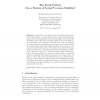Free Online Productivity Tools
i2Speak
i2Symbol
i2OCR
iTex2Img
iWeb2Print
iWeb2Shot
i2Type
iPdf2Split
iPdf2Merge
i2Bopomofo
i2Arabic
i2Style
i2Image
i2PDF
iLatex2Rtf
Sci2ools
SSS
2007
Springer
2007
Springer
The Truth System: Can a System of Lying Processes Stabilize?
We introduce a new abstract system, called the truth system. In the truth system, a process deduces a true value, with high probability, from an incoming stream of both true and false values, where the probability that a value in the incoming stream is true is at least 0.6. At each instant, the receiving process maintains at most one candidate of the true value, and eventually the process reaches the conclusion that its candidate value equals, with high probability, the true value. In this paper, we present three versions of the truth system, discuss their properties, and show how to choose their parameters so that their probability of error is small, i.e. about 10−6 . The third version, called the stable system, is the most valuable. We employ the stable system as a building block in a stabilizing unidirectional token ring of n processes. When n is small, i.e. about 100 or less, the stable system can be considered errorfree and we argue that the resulting token ring is stabilizing w...
| Added | 09 Jun 2010 |
| Updated | 09 Jun 2010 |
| Type | Conference |
| Year | 2007 |
| Where | SSS |
| Authors | Mohamed G. Gouda, Yan Li |
Comments (0)

